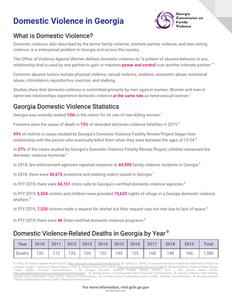Domestic Violence in Georgia
What is Domestic Violence?
Domestic violence, also described by the terms family violence, intimate partner violence, and teen dating violence, is a widespread problem in Georgia and across the country.
The Office of Violence Against Women defines domestic violence as "a pattern of abusive behavior in any relationship that is used by one partner to gain or maintain power and control over another intimate partner."1
Common abusive tactics include physical violence, sexual violence, isolation, economic abuse, emotional abuse, intimidation, reproductive coercion, and stalking.
Studies show that domestic violence is committed primarily by men against women. Women and men in same-sex relationships experience domestic violence a t the same rate as heterosexual women.2
Georgia Domestic Violence Statistics
Georgia was recently ranked 10th in the nation for its rate of men killing women.3
Firearms were the cause of death in 7 3% of recorded domestic violence fatalities in 2019.4
49% of victims in cases studied by Georgia's Domestic Violence Fatality Review Project began their relationship with the person who eventually killed them when they were between the ages of 13-24.5
In 3 7% of the cases studied by Georgia's Domestic Violence Fatality Review Project, children witnessed the domestic violence homicide.5
In 2018, law enforcement agencies reported response to 4 4,900 family violence incidents in Georgia.6
In 2018, there were 26,672 protective and stalking orders issued in Georgia.7
In FFY 2019, there were 6 6,151 crisis calls to Georgia's certified domestic violence agencies.8
In FFY 2019, 5,024 victims and children were provided 7 4,633 nights of refuge in a Georgia domestic violence shelters.8
In FFY 2019, 7,530 victims made a request for shelter but their request was not met due to lack of space.8
In FFY 2019, there were 4 6 State-certified domestic violence programs.8
Domestic Violence-Related Deaths in Georgia by Year 9
Year 2010 2011 2012 2013 2014 2015 2016 2017 2018 2019 Total
Deaths 135 112 135 124 122 145 125 168
148
166 1,380
1. Office of Violence Against Women (2012). http://www.ovw.usdoj.gov/domviolence.htm 2. Turell, S. C. (2000). "A descriptive analysis of same-sex relationship violence for
a diverse sample." Journal of Family Violence. 15(3). 3. Violence Policy Center (2019). http://vpc.org/studies/wmmw2019.pdf 4. Georgia Domestic Violence Fatality Review
Project (2020). Personal Communication.
5. Georgia Domestic Violence Fatality Review Project, 2018 | 15th Annual Report (2018).
http://georgiafatalityreview.com/reports/report/2018-report/ 6. Georgia Bureau of Investigation (2020). Personal Communication. 7. Georgia Protective Order Registry,
Georgia Crime Information Center (2020). Personal Communication. 8. Criminal Justice Coordinating Council (2020). Personal Communication. 9. Georgia Domestic
Violence Fatality Review Project (2020). Personal Communication.
For more information, visit gcfv.ga.gov
REVISED MAY 2020
Domestic Violence in Georgia
Murder-Suicide in Georgia10
Category Number of completed murder-suicides Attempted murder-suicides where the victim or perpetrator died from their injuries Total lives lost in attempted and completed murder-suicides Percentage of all domestic violence-related deaths in Georgia Percentage of all domestic violence-related incidents that resulted in a death Percentage of incidents perpetrated by men Percentage of incidents that involved the use of a firearm
2019 26 4 63 38% 25% 97% 97%
National Domestic Violence Statistics
1 in 5 women and 1 in 7 men have experienced severe physical violence by an intimate partner (e.g., hit
with a fist or something hard, beaten, slammed against something) at some point in their lifetime.11
1 in 6 women and 1 in 17 men have been stalked by an intimate partner during their lifetime to the point
in which they felt very fearful or believed that they or someone close to them would be harmed or killed.1 1
From 1994 to 2010, about 4 in 5 victims of intimate partner violence were women.1 2
The presence of a gun in a domestic violence situation increases the risk of homicide by 500%. 13
Immigrants and refugees experience violence at the same rates as other communities.1 4
15.5 million children witnessed domestic violence at least once in the past year.15
Among high school students who dated, 2 1% of girls and 1 0% of boys experienced physical and/or sexual
dating violence.1 6
1-800-33-HAVEN (voice/TTY & Spanish)
If you or someone you know is being abused, there are community and statewide resources available to you. Call the toll-free, 24-hour hotline for a confidential place to get help and find resources.
10. Georgia Domestic Violence Fatality Review Project (2020). Personal Communication. 11. National Intimate Partner and Sexual Violence Survey (2018). https://www.cdc.gov/violenceprevention/pdf/2015data-brief508.pdf 12. Bureau of Justice Statistics (2013). https://www.bjs.gov/content/pub/pdf/ipvav9311.pdf 13. Campbell, et al. (2003). Risk Factors for Femicide in Abusive Relationships: Results From a Multisite Case Control Study. Retrieved from http://www.ncbi.nlm.nih.gov/pmc/articles/PMC1447915/ 14. Tjaden P., & Thoennes, N. (2000). "Full Report of the Prevalence, Incidence, and Consequences of Violence Against Women." National Institute of Justice. www.ncjrs.gov/pdffiles1/nij/183781.pdf. 15. Whitfield, C., et al. (2003). "Violent Childhood Experiences and the Risk of Intimate Partner Violence in Adults." Journal of Interpersonal Violence. 18 (2). 16. Vagi KJ, Olsen EOM, Basile KC, Vivolo-Kantor AM (2015). Teen dating violence (physical and sexual) among US high school students: Findings from the 2013 National Youth Risk Behavior Survey. JAMA Pediatrics; 169(5):474-482. ----- REVISED MAY 2020
For more information, visit gcfv.ga.gov
REVISED MAY 2020
